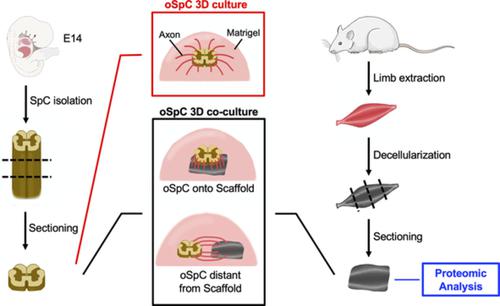当前位置:
X-MOL 学术
›
Stem Cells Transl. Med.
›
论文详情
Our official English website, www.x-mol.net, welcomes your
feedback! (Note: you will need to create a separate account there.)
Decellularized skeletal muscles display neurotrophic effects in three-dimensional organotypic cultures.
STEM CELLS Translational Medicine ( IF 5.4 ) Pub Date : 2020-06-24 , DOI: 10.1002/sctm.20-0090 Paolo Raffa 1, 2 , Valentina Scattolini 1, 2 , Mattia Francesco Maria Gerli 3 , Silvia Perin 3 , Meihua Cui 4 , Paolo De Coppi 3 , Nicola Elvassore 1, 3, 4, 5 , Paola Caccin 6 , Camilla Luni 4 , Anna Urciuolo 3, 7
STEM CELLS Translational Medicine ( IF 5.4 ) Pub Date : 2020-06-24 , DOI: 10.1002/sctm.20-0090 Paolo Raffa 1, 2 , Valentina Scattolini 1, 2 , Mattia Francesco Maria Gerli 3 , Silvia Perin 3 , Meihua Cui 4 , Paolo De Coppi 3 , Nicola Elvassore 1, 3, 4, 5 , Paola Caccin 6 , Camilla Luni 4 , Anna Urciuolo 3, 7
Affiliation

|
Skeletal muscle decellularization allows the generation of natural scaffolds that retain the extracellular matrix (ECM) mechanical integrity, biological activity, and three‐dimensional (3D) architecture of the native tissue. Recent reports showed that in vivo implantation of decellularized muscles supports muscle regeneration in volumetric muscle loss models, including nervous system and neuromuscular junctional homing. Since the nervous system plays pivotal roles during skeletal muscle regeneration and in tissue homeostasis, support of reinnervation is a crucial aspect to be considered. However, the effect of decellularized muscles on reinnervation and on neuronal axon growth has been poorly investigated. Here, we characterized residual protein composition of decellularized muscles by mass spectrometry and we show that scaffolds preserve structural proteins of the ECM of both skeletal muscle and peripheral nervous system. To investigate whether decellularized scaffolds could per se attract neural axons, organotypic sections of spinal cord were cultured three dimensionally in vitro, in presence or in absence of decellularized muscles. We found that neural axons extended from the spinal cord are attracted by the decellularized muscles and penetrate inside the scaffolds upon 3D coculture. These results demonstrate that decellularized scaffolds possess intrinsic neurotrophic properties, supporting their potential use for the treatment of clinical cases where extensive functional regeneration of the muscle is required.
中文翻译:

脱细胞骨骼肌在三维器官培养中表现出神经营养作用。
骨骼肌去细胞化允许生成保留细胞外基质 (ECM) 机械完整性、生物活性和天然组织三维 (3D) 结构的天然支架。最近的报告表明,脱细胞肌肉的体内植入支持体积肌肉损失模型中的肌肉再生,包括神经系统和神经肌肉接头归巢。由于神经系统在骨骼肌再生和组织稳态过程中起着关键作用,因此神经支配的支持是需要考虑的关键方面。然而,脱细胞肌肉对神经再支配和神经元轴突生长的影响研究很少。这里,我们通过质谱法表征了脱细胞肌肉的残留蛋白质组成,并表明支架保留了骨骼肌和周围神经系统 ECM 的结构蛋白。为了研究脱细胞支架本身是否可以吸引神经轴突,在存在或不存在脱细胞肌肉的情况下,在体外三维培养脊髓的器官切片。我们发现从脊髓延伸出来的神经轴突被脱细胞肌肉吸引并在 3D 共培养时渗透到支架内部。这些结果表明,脱细胞支架具有内在的神经营养特性,支持它们在治疗需要肌肉广泛功能再生的临床病例中的潜在用途。
更新日期:2020-06-24
中文翻译:

脱细胞骨骼肌在三维器官培养中表现出神经营养作用。
骨骼肌去细胞化允许生成保留细胞外基质 (ECM) 机械完整性、生物活性和天然组织三维 (3D) 结构的天然支架。最近的报告表明,脱细胞肌肉的体内植入支持体积肌肉损失模型中的肌肉再生,包括神经系统和神经肌肉接头归巢。由于神经系统在骨骼肌再生和组织稳态过程中起着关键作用,因此神经支配的支持是需要考虑的关键方面。然而,脱细胞肌肉对神经再支配和神经元轴突生长的影响研究很少。这里,我们通过质谱法表征了脱细胞肌肉的残留蛋白质组成,并表明支架保留了骨骼肌和周围神经系统 ECM 的结构蛋白。为了研究脱细胞支架本身是否可以吸引神经轴突,在存在或不存在脱细胞肌肉的情况下,在体外三维培养脊髓的器官切片。我们发现从脊髓延伸出来的神经轴突被脱细胞肌肉吸引并在 3D 共培养时渗透到支架内部。这些结果表明,脱细胞支架具有内在的神经营养特性,支持它们在治疗需要肌肉广泛功能再生的临床病例中的潜在用途。











































 京公网安备 11010802027423号
京公网安备 11010802027423号